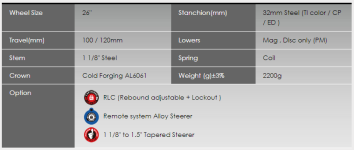Big Tom
10 W
With a eZee 500 watt motor (20" front hub), 52v and a Spinner 300 front fork. Would there be a need or benefit of installing a second torque arm (grin's V3) to match both sides.
Thanks, Tom
Thanks, Tom

Well actually.. if this is your fork, then you're in luck.
32mm steel stanchions, magnesium lowers..
Magnesium is weaker and less stiff than aluminum. A magnesium wrench would be useless, and that's the kind of job a fork tip is being asked to do when you put a hub motor in it.
"High strength" (relative to other Mg alloys) magnesium is very brittle. Weaker structural alloys can be somewhat ductile. Cast metals are almost always more brittle than forged or wrought versions of the same metals, and fork lowers are cast. I can't guess whether typical aluminum fork lowers are more or less likely to snap off than typical magnesium ones, but I am certain that a steel axle would have an easier time carving its threads through mag fork tips.But does it shatter/shear before bending after too many wear cycles like aluminum does?
I'm no materials expert but i get the impression that magnesium is somewhere between aluminum and steel in terms of this.
Correct me if i'm wrong.

 endless-sphere.com
endless-sphere.com
The fork telescopics are aligned with an approximate vector of rider weight + bump forces + braking forces. It's very oblique to propulsive forces from a hub motor.Arent braking forces on a fork 10x what a motor will produce? The caliper mount is on the lower and the weight of me and the bike are on the upper. Seems like fork bushings are made precisely for these type of forces.
Want front suspension? Ditch to suspension fork and spring for a Schwalbe 20x2.15 Big apple or the Schwalbe 20x2.40 Super Moto (the latter unfortunately, is becoming difficult to source stateside). Both are verifiably amazing... especially on chip-seal.With a eZee 500 watt motor (20" front hub), 52v and a Spinner 300 front fork. Would there be a need or benefit of installing a second torque arm (grin's V3) to match both sides.
Thanks, Tom
I currently have a front wheel hub on a Hase Lepus Comfort (delta trike) with a 16" wheel. I normally use Big Apple tires (have difficulty sourcing them most times) and I have found that most times when on longer rides I wished I had more suspension. Longer rides I had started to not really enjoy the ride. My front wheel is not loaded with any weight so it is not any weight related roughness.Want front suspension? Ditch to suspension fork and spring for a Schwalbe 20x2.15 Big apple or the Schwalbe 20x2.40 Super Moto (the latter unfortunately, is becoming difficult to source stateside). Both are verifiably amazing... especially on chip-seal.
Isn't that why the thru-axle wheel hubs came to the market?? Does a disc front brake on the left side when applied put a twisting force on front forks. Especially the cheap ones

 www.roadbikerider.com
www.roadbikerider.com
Isn't that why the thru-axle wheel hubs came to the market?
